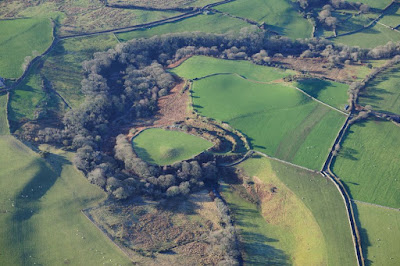Craig-Y-Dinas/Caer Dathal, Arfon, Gwynedd, Wales
In several recent articles, I have discussed what I believe to be Geoffrey of Monmouth's relocation of Arthur's Caer Dathal in Gwynedd to Tintagel in Cornwall. Two of the more important posts can be found at the following links:
Do we dare ignore the only extant strand of tradition that appears to identify Arthur's point of origin?
I fear we must. Why? Because Arthur's association with Caer Dathal may well be a Welsh relocation of Geoffrey's Tintagel. In other words, Iaen, 'piece of ice', for Geoffrey's Eigr (thought to be Irish aigre/eigre), may have been created and placed at Caer Dathal. The two places have second elements which are similar (if not identical), and we know that Math son of Mathonwy, a bear god, may have been associated with Arthur, whose name was regularly related to W. arth, 'bear.'
The motif of Lleu as a death-eagle in an oak may have been copied for Eliwlad son of Madog son of Uther simply because someone knew there were Cut/Coed Madog place-names both near Glynn in Cornwall and near Nantlle in Gwynedd. This last would have been made especially attractive had Uther already been associated with Caer Dathal.
If we insist on Uther and Arthur at Caer Dathal, we run into some major problems. Iaen is a fanciful name. There are many such in CULHWCH AND OLWEN. If it were used for Eigr, then that means Eigr comes first, and Tintagel would have precedence over Caer Dathal. Celticists will not accept that Iaen could represent an Irish tribal group. I have tried all possible candidates for such, and none are deemed linguistically acceptable. The personal name is what it is, and it is purely Welsh.
We are also left with no traceable line of descent for Uther, and none for Madog. Essentially, we find ourselves back at square one.
Given this uncertainty, which is rather profound, I must conclude that this tradition from the MABINOGION is no more reliable than what is preserved in the Galfridian tradition.
The motif of Lleu as a death-eagle in an oak may have been copied for Eliwlad son of Madog son of Uther simply because someone knew there were Cut/Coed Madog place-names both near Glynn in Cornwall and near Nantlle in Gwynedd. This last would have been made especially attractive had Uther already been associated with Caer Dathal.
If we insist on Uther and Arthur at Caer Dathal, we run into some major problems. Iaen is a fanciful name. There are many such in CULHWCH AND OLWEN. If it were used for Eigr, then that means Eigr comes first, and Tintagel would have precedence over Caer Dathal. Celticists will not accept that Iaen could represent an Irish tribal group. I have tried all possible candidates for such, and none are deemed linguistically acceptable. The personal name is what it is, and it is purely Welsh.
We are also left with no traceable line of descent for Uther, and none for Madog. Essentially, we find ourselves back at square one.
Given this uncertainty, which is rather profound, I must conclude that this tradition from the MABINOGION is no more reliable than what is preserved in the Galfridian tradition.

No comments:
Post a Comment
Note: Only a member of this blog may post a comment.